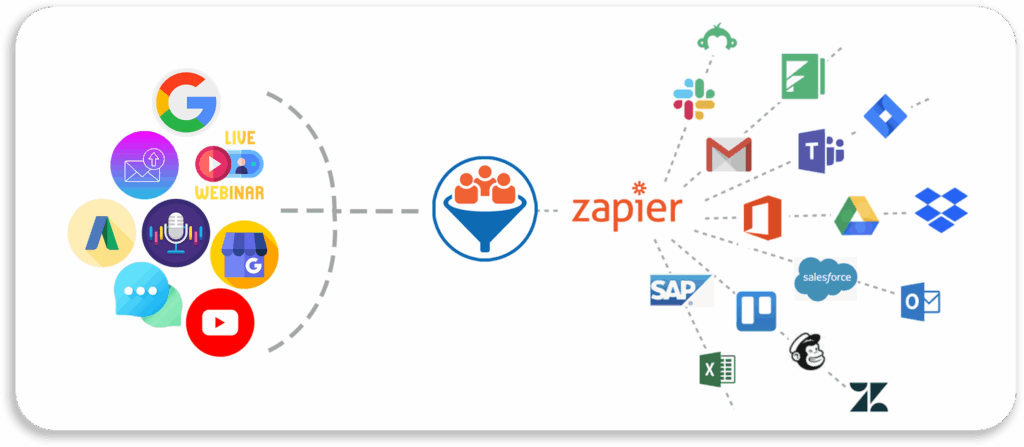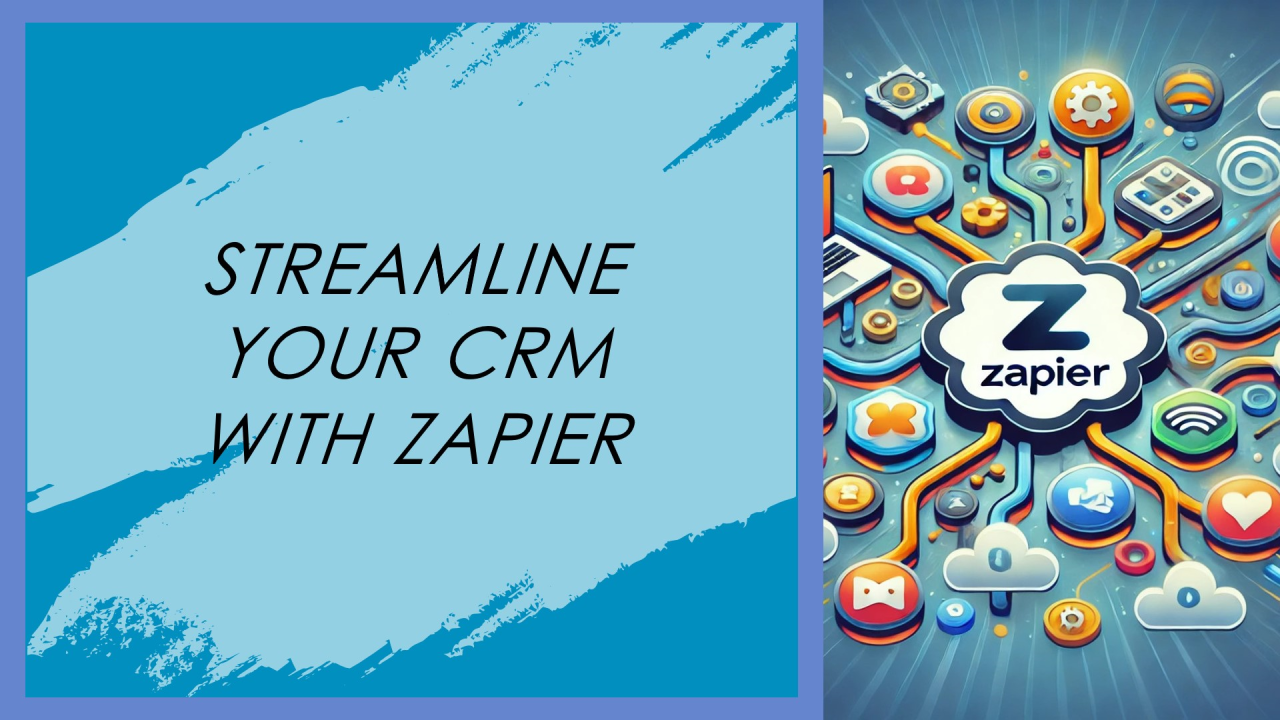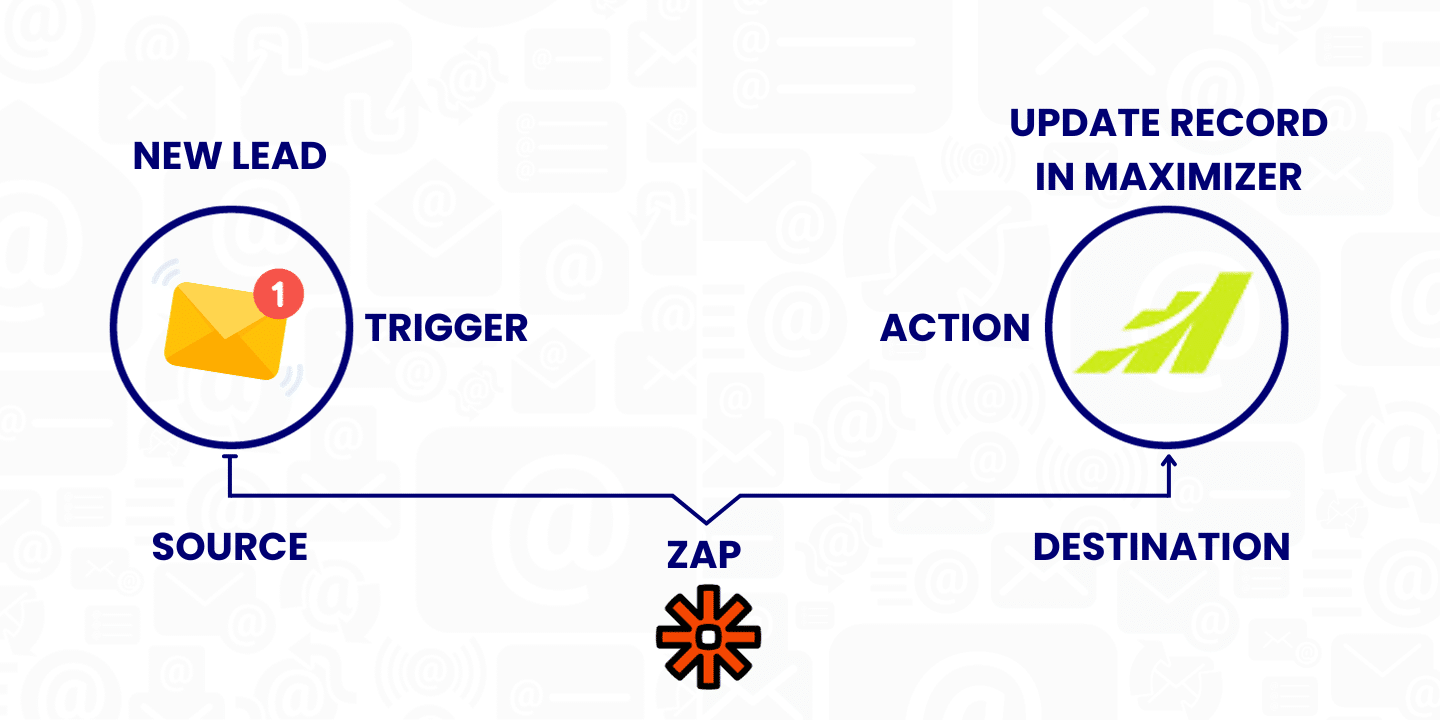
Unlock CRM Superpowers: A Deep Dive into CRM Integration with Zapier
In today’s fast-paced digital landscape, businesses rely on a multitude of tools to manage their operations, connect with customers, and drive growth. At the heart of many successful organizations lies a Customer Relationship Management (CRM) system, a central hub for managing interactions and data related to customers. However, a CRM in isolation is often not enough. To truly maximize efficiency and unlock the full potential of your CRM, integration with other essential applications is crucial. This is where Zapier comes in, offering a powerful and user-friendly solution for connecting your CRM with hundreds of other apps, automating workflows, and streamlining your business processes.
This comprehensive guide will delve deep into the world of CRM integration with Zapier. We’ll explore the benefits, provide step-by-step instructions for various integrations, discuss best practices, and address common challenges. Whether you’re a seasoned CRM user or just starting out, this article will equip you with the knowledge and tools you need to harness the power of Zapier and transform your CRM into a true business powerhouse.
Why Integrate Your CRM with Zapier? The Benefits Explained
Before we dive into the “how,” let’s explore the “why.” Why should you bother integrating your CRM with Zapier? The answer lies in the multitude of benefits it offers:
- Automation of Repetitive Tasks: Zapier excels at automating tedious, manual tasks. Imagine automatically adding new leads from a contact form on your website to your CRM, sending personalized welcome emails, or updating contact information based on responses to a survey. Automating these tasks frees up your team’s time, allowing them to focus on more strategic initiatives.
- Increased Efficiency: By connecting your CRM with other apps, you eliminate the need to manually transfer data between systems. This reduces errors, saves time, and improves overall efficiency. For example, when a deal is closed in your CRM, you can automatically trigger the creation of a project in your project management software, saving you valuable time and effort.
- Improved Data Accuracy: Manual data entry is prone to errors. Zapier ensures that data is transferred accurately and consistently between your CRM and other applications. This leads to more reliable data, which is crucial for making informed business decisions.
- Enhanced Customer Experience: Automated workflows can personalize the customer experience. For example, when a customer makes a purchase, you can automatically trigger the sending of a thank-you email or add them to a specific marketing campaign. This level of personalization fosters customer loyalty and satisfaction.
- Cost Savings: By automating tasks and improving efficiency, Zapier can help you reduce operational costs. You can free up your employees from time-consuming manual tasks, allowing them to focus on more valuable activities that contribute to revenue generation.
- Seamless Integration with Hundreds of Apps: Zapier connects with thousands of popular apps, including email marketing platforms, social media channels, e-commerce platforms, project management tools, and more. This allows you to create a truly integrated ecosystem tailored to your specific business needs.
- Real-time Data Synchronization: Zapier allows for real-time or near-real-time data synchronization between your CRM and other apps. This ensures that your data is always up-to-date, providing you with a clear and accurate view of your business operations.
Popular CRM Systems and Zapier Integration Capabilities
Zapier offers robust integration capabilities with a wide range of CRM systems. Here are some of the most popular CRM platforms and examples of how they can be integrated with Zapier:
Salesforce
Salesforce is a leading CRM platform known for its comprehensive features and scalability. Zapier allows you to integrate Salesforce with various apps, including:
- Email Marketing: Automatically add new Salesforce leads to your email marketing lists in platforms like Mailchimp or ActiveCampaign.
- Project Management: Create new projects in Asana or Trello when a deal is closed in Salesforce.
- Communication: Send Slack notifications when a new opportunity is created or a deal is won.
HubSpot CRM
HubSpot CRM is a popular choice for businesses of all sizes due to its user-friendliness and comprehensive marketing, sales, and customer service features. Zapier integration with HubSpot offers a range of possibilities:
- Lead Capture: Automatically add new leads from your website forms or other sources to HubSpot.
- Workflow Automation: Trigger automated workflows in HubSpot based on actions in other apps, such as sending personalized emails or updating deal stages.
- Data Synchronization: Keep data synchronized between HubSpot and other apps, such as your e-commerce platform or accounting software.
Zoho CRM
Zoho CRM is a versatile CRM platform with a focus on sales and marketing automation. Zapier integration with Zoho CRM allows you to:
- Lead Generation: Automatically capture leads from various sources, such as website forms, social media, and online advertising campaigns.
- Sales Automation: Automate sales processes, such as sending follow-up emails, creating tasks, and updating deal stages.
- Reporting and Analytics: Integrate Zoho CRM with other apps to create custom reports and gain deeper insights into your sales performance.
Pipedrive
Pipedrive is a sales-focused CRM designed for ease of use and visual pipeline management. Zapier integration enhances Pipedrive’s capabilities by allowing you to:
- Contact Management: Automatically add new contacts from various sources to Pipedrive.
- Deal Automation: Automate deal creation, updates, and stage progression.
- Communication: Send personalized emails and SMS messages based on deal stages or other triggers.
Microsoft Dynamics 365
Microsoft Dynamics 365 is a comprehensive CRM platform that integrates seamlessly with other Microsoft products. Zapier integration with Dynamics 365 enables you to:
- Data Synchronization: Keep data synchronized between Dynamics 365 and other apps, such as your email marketing platform or accounting software.
- Workflow Automation: Automate workflows, such as creating tasks, sending notifications, and updating records.
- Reporting and Analytics: Integrate Dynamics 365 with other apps to create custom reports and gain deeper insights into your sales performance.
These are just a few examples, and Zapier supports integration with many other CRM systems. The possibilities are vast, and the specific integrations you choose will depend on your business needs and the apps you use.
Step-by-Step Guide: Setting Up CRM Integrations with Zapier
Now, let’s get practical. Here’s a step-by-step guide to setting up CRM integrations with Zapier. We’ll use a general example to illustrate the process, but the specific steps may vary slightly depending on the apps you’re connecting.
- Sign Up for Zapier: If you don’t already have a Zapier account, sign up for one at zapier.com. Zapier offers a free plan with limited features, as well as paid plans with more advanced capabilities.
- Choose Your Trigger App: The trigger app is the app that starts the Zap. This is the app where the event happens that will initiate the workflow. For example, if you want to add a new contact to your CRM when someone submits a form on your website, your form builder (e.g., Typeform, Google Forms) would be the trigger app.
- Choose Your Action App: The action app is the app where the action will take place. This is the app that will be updated or modified based on the trigger event. In our example, your CRM (e.g., Salesforce, HubSpot, Zoho CRM) would be the action app.
- Connect Your Accounts: Connect your accounts for both the trigger app and the action app to Zapier. You’ll typically be prompted to log in to your accounts and grant Zapier access.
- Set Up the Trigger: Configure the trigger event. This involves specifying the exact event that will start the Zap. For example, you might choose “New Form Submission” in your form builder. You’ll also need to select the specific form you want to use.
- Set Up the Action: Configure the action. This involves specifying what you want to happen in your CRM when the trigger event occurs. For example, you might choose “Create Contact” in your CRM app. You’ll then need to map the data from the trigger app to the corresponding fields in your CRM. For instance, you’ll map the “Name” field from your form to the “First Name” and “Last Name” fields in your CRM.
- Test Your Zap: Before activating your Zap, it’s essential to test it. Zapier allows you to test your Zap with sample data to ensure that it’s working correctly. This will help you identify and fix any potential issues before the Zap goes live.
- Turn On Your Zap: Once you’ve tested your Zap and confirmed that it’s working as expected, turn it on. Your Zap will now run automatically whenever the trigger event occurs.
- Monitor Your Zap: After your Zap is live, it’s important to monitor its performance. Zapier provides logs and analytics that allow you to track the number of times your Zap has run, identify any errors, and ensure that your workflow is functioning as intended.
Important Considerations:
- Data Mapping: Carefully map the data fields from your trigger app to the corresponding fields in your action app. This ensures that the correct data is transferred accurately.
- Field Requirements: Pay attention to any required fields in your CRM. Make sure that you’re providing data for all required fields in the action step.
- Error Handling: Be prepared to handle potential errors. Zapier can sometimes encounter errors due to various factors, such as API limitations or data format issues. Familiarize yourself with Zapier’s error handling features to troubleshoot any problems that may arise.
- Testing and Iteration: Test your Zaps thoroughly before activating them. Review the logs and analytics regularly and make adjustments as needed to optimize your workflows.
Advanced CRM Integration Strategies with Zapier
Once you’ve mastered the basics, you can explore more advanced CRM integration strategies to further optimize your business processes. Here are some ideas:
Multi-Step Zaps
Multi-step Zaps allow you to chain multiple actions together, creating complex workflows that automate a series of tasks. For example, you could create a multi-step Zap that:
- Adds a new lead from a website form to your CRM.
- Sends a personalized welcome email to the lead.
- Creates a task for a sales representative to follow up with the lead.
Conditional Logic
Zapier’s conditional logic allows you to create Zaps that perform different actions based on specific criteria. For example, you could use conditional logic to:
- Send different email sequences based on the lead source.
- Assign leads to different sales representatives based on their location.
- Update deal stages based on the value of the deal.
Data Formatting and Transformation
Zapier provides tools for formatting and transforming data. This allows you to clean, format, and manipulate data before it’s transferred to your CRM or other apps. For example, you could:
- Format phone numbers to a consistent format.
- Capitalize names and addresses.
- Extract specific information from text fields.
Webhooks
Webhooks allow you to trigger Zaps based on real-time events in your apps. This enables you to create highly responsive and automated workflows. For example, you could use webhooks to:
- Receive instant notifications when a new order is placed in your e-commerce platform.
- Trigger a workflow when a customer updates their profile information.
Filtering
Filtering allows you to specify which data should be processed by your Zap. This can be useful for filtering out irrelevant data or focusing on specific types of records. For instance, you can filter leads based on their industry, budget, or other relevant criteria.
Troubleshooting Common CRM Integration Issues
Even with the power of Zapier, you may encounter some challenges when setting up and managing CRM integrations. Here are some common issues and how to troubleshoot them:
- Data Mapping Errors: Incorrect data mapping is a frequent cause of problems. Double-check that you’ve mapped the correct fields from your trigger app to the corresponding fields in your action app. Ensure that the data types are compatible (e.g., text fields mapped to text fields, numbers to numbers).
- API Rate Limits: Some apps have API rate limits, which restrict the number of requests you can make within a certain time period. If you exceed these limits, your Zap may stop working. Contact the support for your apps to identify and manage these limitations. Consider optimizing your Zap’s execution frequency or upgrading to a higher Zapier plan that offers higher rate limits.
- Missing Required Fields: Ensure that you’re providing data for all required fields in your CRM. If a required field is missing, your Zap may fail. Review the documentation for your CRM to identify required fields.
- Incorrect Account Connections: Verify that you’ve correctly connected your accounts to Zapier. Sometimes, the connection can become disconnected or require re-authentication. Reconnect your accounts and test your Zap.
- Incorrect Trigger or Action Setup: Double-check that you’ve configured the trigger and action steps correctly. Make sure you’ve selected the correct trigger event and action event. Review the settings for each step to ensure they’re configured as intended.
- Data Formatting Issues: Inconsistent data formatting can sometimes cause problems. For example, if you’re trying to transfer a phone number, make sure it’s in the correct format. Use Zapier’s data formatting tools to clean and standardize your data.
- Zapier Errors: Zapier provides detailed error logs that can help you diagnose problems. Review the error logs to identify the cause of any failures. The logs often provide specific error messages and suggestions for resolving the issue.
- App-Specific Issues: Each app has its own unique quirks and limitations. Consult the app’s documentation or support resources for specific troubleshooting tips. Zapier’s help documentation also provides specific guides for integrating with various apps.
Best Practices for CRM Integration with Zapier
To maximize the effectiveness of your CRM integrations with Zapier, follow these best practices:
- Plan Your Workflows: Before you start creating Zaps, take the time to plan your workflows. Identify the specific tasks you want to automate, the apps you need to connect, and the data you need to transfer.
- Start Small and Test Thoroughly: Begin with simple Zaps and test them thoroughly before implementing more complex workflows. This will help you identify and resolve any issues early on.
- Document Your Zaps: Document your Zaps, including the trigger and action apps, the data mapping, and any conditional logic or filters. This will make it easier to troubleshoot and maintain your Zaps over time.
- Monitor Your Zaps Regularly: Monitor your Zaps regularly to ensure they’re running correctly. Review the logs and analytics and make adjustments as needed.
- Use Descriptive Names: Give your Zaps descriptive names that clearly indicate their purpose. This will make it easier to manage your Zaps.
- Organize Your Zaps: Organize your Zaps into folders or categories to keep them organized.
- Keep Your Apps Updated: Make sure your apps are up to date. Updates often include bug fixes and new features that can improve the performance of your Zaps.
- Leverage Zapier’s Support Resources: Zapier provides extensive documentation, tutorials, and support resources. Take advantage of these resources to learn more about Zapier and troubleshoot any issues you encounter.
- Stay Informed: The world of CRM and marketing automation is constantly evolving. Keep up with the latest trends and technologies to optimize your processes.
The Future of CRM and Automation
The integration of CRM systems with automation platforms like Zapier is not just a trend; it’s the future of business efficiency. As technology continues to advance, we can expect to see even more sophisticated integrations and automation capabilities. Here are some trends to watch:
- AI-Powered Automation: Artificial intelligence (AI) is already playing a significant role in CRM and automation. We can expect to see more AI-powered features, such as automated lead scoring, predictive analytics, and personalized customer interactions.
- Increased Personalization: Businesses are increasingly focused on providing personalized experiences to their customers. Automation will play a key role in enabling this, allowing businesses to tailor their communications, offers, and services to individual customer preferences.
- Integration of Emerging Technologies: We’ll see more integrations with emerging technologies, such as voice assistants, the Internet of Things (IoT), and augmented reality (AR).
- No-Code Automation: The rise of no-code automation platforms like Zapier is empowering businesses to automate complex workflows without requiring coding skills. This trend will continue to grow, making automation accessible to a wider audience.
- Focus on Customer Experience: The customer experience is becoming a key differentiator for businesses. Automation will be used to streamline customer interactions, improve response times, and provide a more seamless and personalized experience.
By embracing these trends and leveraging the power of CRM integration with Zapier, businesses can position themselves for success in the ever-evolving digital landscape.
Conclusion: Unleash the Power of CRM with Zapier
CRM integration with Zapier is a game-changer for businesses of all sizes. By automating tasks, improving efficiency, enhancing customer experiences, and reducing costs, you can transform your CRM into a true business powerhouse. This guide has provided you with the knowledge and tools you need to get started, from understanding the benefits and setting up integrations to troubleshooting common issues and exploring advanced strategies.
Take the time to plan your workflows, test your Zaps thoroughly, and monitor their performance. Embrace the best practices and stay informed about the latest trends in CRM and automation. By doing so, you can unlock the full potential of your CRM and drive sustainable growth for your business.
So, what are you waiting for? Start integrating your CRM with Zapier today and experience the transformative power of automation!

